Looking at the Sun — A Warning and A Suggestion
This page discusses events that occur when the Moon passes in front of the Sun. After reading it you should feel some enthusiasm about looking at the Sun when one of those events occurs. However, a warning is in order:
All solar images on this site were taken with filters that blocked at least 99.999% of the light of the Sun (all of its light, including not only visible light but also infrared and ultraviolet radiation). Looking at the Sun during an eclipse or transit is no more dangerous than looking at it at any other time, but it is ALWAYS dangerous to stare at the Sun without filters that block almost all of the Sun's radiation. Looking at the Sun with sunglasses or other filters not specifically made for looking at the Sun can result in partial or total blindness. (For examples of solar eclipse viewers that meet recommended safety standards, check out these cardboard eclipse sunglasses or these plastic ones; or to safely view the Sun larger than life, check out these 6x binoculars and these 10x Celestron binoculars. There are many variations on this theme, but what the holders for the eclipse viewers look like doesn't matter, as long as they are "CE AND ISO CERTIFIED FOR DIRECT SUN VIEWING".) Even with safe eclipse filters some doctors recommend only observing the Sun for a few minutes at most, then giving your eyes a rest; if you see an afterimage of the Sun when you rest your eyes, you should observe it for shorter periods.
One way of safely looking at the Sun is to use a "pinhole camera", which can be as simple as an opaque piece of paper or cardboard with a very small hole in the middle. Holding the paper a few feet from the ground so that it casts a shadow of itself normally shows a small round ball which is an image of the round disc of the Sun. During a partial eclipse of the Sun the round ball will have a chunk taken out of one side, which is the circular outline of that part of the Moon which is covering the Sun. Most people don't realize it, but the dappled light under trees is often a multitude of pinhole images of the Sun (
see examples here). During solar eclipses, as shown below, those images become crescents representing inverted images of the Sun. During a
planetary transit of the Sun a very tiny black dot might be seen in front of the Sun, gradually passing from its eastern side to its western side, but the dot would be so small it might not be discernable, so direct viewing with a suitable solar filter is more satisfactory.
Image From the Eclipse of May 9, 2013
The annular eclipse of May 9, 2013 was visible as an annular eclipse along a line running across northeastern Australia and the southwestern Pacific Ocean. The image taken from a
webcast video shown below shows most of the 'annulus' or ring of sunlight surrounding the too-distant-to-completely-cover-the-Sun disk of the Moon during the central part of the eclipse (part of the solar annulus is cut off at the top because the telescope image was not properly centered in the webcast video). This image may be copyrighted, and as a result it serves only as a place-holder. In the next iteration of this page I will post a public domain image, as I do not want to use copyrighted images without the express permission of the copyright holder.
 Images From the Eclipse of May 20, 2012
Images From the Eclipse of May 20, 2012
The annular eclipse of May 20, 2012 was visible as an annular eclipse along a line from Eureka in northern California, through Reno, Nevada, northeast of Las Vegas, through Albuquerque, New Mexico, and in Lubbock, Texas. In those regions the Moon passed directly in front of the Sun, but being near apogee looked too small to cover it, leaving a "ring of fire" around the Sun. The images immediately below were taken near Long Beach, California, to the southwest of the path of annularity. As a result the Moon was seen crossing the northern side of the Sun from east (on the right) to west (on the left). The top image was taken with a handheld camera, holding one of the "eyeglass" filters mentioned above in front of the lens. The image isn't as sharp as it would have been if taken with a tripod or with a larger lens but clearly shows the Moon on the upper right of the Sun, near maximum partial eclipse. The images below show the dappled light produced by "pinhole" cameras created by the leaves of a lemon tree in my backyard, shining on a stuccoed wall behind the tree. Scattered across the shadow cast by the tree are irregular openings where leaves didn't block the Sun, and tiny "crescent" images of the Sun, produced by openings so small that they approximated pinhole cameras. Such cameras create an inverted image of the Sun, so when the Moon was on the western (right-hand) side of the Sun, the images cast on the wall were crescents lit on their left-hand side; but as the Moon moved across the northern side of the Sun, the uncovered southern portion of the Sun produced crescents lit on their top. In other words, although the images are inverted, they do allow an observer to follow the progress of the eclipse reasonably well. (Note that the faintest images, which represent the smallest "pinholes", provide the sharpest view of the solar "crescent". Brighter images, representing larger "pinholes", don't provide as accurate an image; and of course if the wall had been smooth instead of rough stucco, the images would have been sharper.)
(All images © Courtney Seligman)
Below, the dappled light from a lemon tree displays inverted crescents lit on the left side

Below, the dappled light from a lemon tree displays inverted crescents lit on the top side

The Shadow of the Moon
As shown in the diagram below, two lines can be drawn from the bottom of the Sun past the Moon, to define a region where the Moon blocks any view of the bottom of the Sun; and similarly, two lines can be drawn from the top of the Sun, past the Moon, to define a region where the Moon blocks any view of the top of the Sun. Where those overlap on the night side of the Moon is the Moon's umbra (Latin for shadow), a region where neither the top nor the bottom of the Sun can be seen (nor of course any part in between). Where they do not overlap is the Moon's penumbra (Latin for partial shadow), a region where part of the Sun is visible and part of it is blocked from view by the Moon. In the upper part of the penumbra the Moon is in front of the bottom of the Sun, but an observer could look over the top of the Moon and still see the top of the Sun; while in the lower part of the penumbra the Moon is in front of the top of the Sun, but an observer could look under the bottom of the Moon and still see the bottom of the Sun.

The shadow of the Moon
(not to scale; objects shown larger and closer than reality)
The umbra is a cone-shaped region as large as the Moon at the center of the Moon, and gradually decreasing in size as you move away from the Moon until — at a distance approximately equal to the size of the Moon's orbit around the Earth — you reach the tip of the cone. At that place the Moon appears to be exactly the same size as the Sun and in exactly the same direction as the Sun, and just barely covers it completely. Moving toward the Moon, the Moon looks larger and larger and the region where the Sun is completely covered grows from a point to a circle about one percent of the size of the distance from the tip. Thus, 100 miles in front of the tip of the umbra the region where the Moon completely covers the Sun is about a mile in diameter, and 10,000 miles in front of the tip of the umbra the region where the Moon completely covers the Sun is about a hundred miles in diameter. Anyone who is inside the umbra sees a total eclipse of the Sun, but since the tip of the umbra never reaches more than a few thousand miles past the surface of the Earth, the portion of the Earth's surface which is inside the circle of totality at any given time is never much more than a hundred miles across, and is usually considerably smaller.
Moving further from the tip of the umbra the Moon looks smaller and smaller, and in fact too small to completely cover the Sun, so that a ring of Sun is visible all around the Moon. This ring is called an annulus (Latin for ring), so an eclipse in which the tip of the Moon's umbra doesn't reach the Earth is called an annular eclipse.
Surrounding the umbra, and growing as you move away from the Moon at the same rate that the umbra is shrinking, is the penumbra. The top portion of the penumbra represents the region where the bottom of the Sun is blocked from view, but you can look over the top of the Moon and see the top of the Sun. The central portion of the penumbra represents the area behind the umbra where the Moon is directly in front of the Sun, but is too small to cover it completely, so you see an annular eclipse. The bottom portion of the penumbra represents the region where the top of the Sun is blocked from view, but you can look under the bottom of the Moon and see the bottom of the Sun. All three regions in the penumbra see a partial eclipse of the Sun, but annular eclipses are considered special cases, and are usually listed with total solar eclipses for the reason discussed immediately below.
Sometimes, as the Moon sweeps past the Earth the tip of the umbra reaches the surface of the Earth on the portion closest to the Moon (as shown in the diagram), but does not reach as far as the center of the Earth. When this happens, that part of the Earth which is close enough to the Moon to fall within the umbra sees a very short solar eclipse, while that part which is further away from the Moon sees a very short annular eclipse. Such an eclipse is called a total-annular or hybrid eclipse.
The Motion of the Moon Across the Sun

The total solar eclipse of March 29, 2006 as a composite series of exposures, showing the Moon gradually covering the Sun as they move eastward along the Ecliptic, while the rotation of the Earth carries both objects westward. Partial phases become deeper and deeper as totality approaches, and shallower and shallower after totality. The exposure times for partial phases are very short, while the image of the corona at totality requires a longer exposure.
(Original image, including a gorgeous view of the Turkish coastline, © Stefan Seip, apod060404)
The Motion of the Moon's Shadow Across the Earth

The path of the total solar eclipse of August 11, 1999. (Fred Espenak (GSFC), NASA, apod990810)
The region of totality, which is never more than about a hundred miles across, sweeps across the Earth from west to east as the Moon moves around us, passing in front of the Sun. The map above shows the region of totality as a narrow band running from the area where the eclipse takes place at sunrise (on the left side of the map) to the area where the eclipse takes place at sunset (on the right side of the map). The regions above and below the region of totality see a partial eclipse. Above the region of totality, viewers see the Moon in front of the bottom of the Sun, but looking above the Moon, still see the top of the Sun. Below the region of totality, viewers see the Moon in front of the top of the Sun, but looking below the Moon, still see the bottom part of the Sun. Only in the region of totality is the Sun completely covered by the Moon.
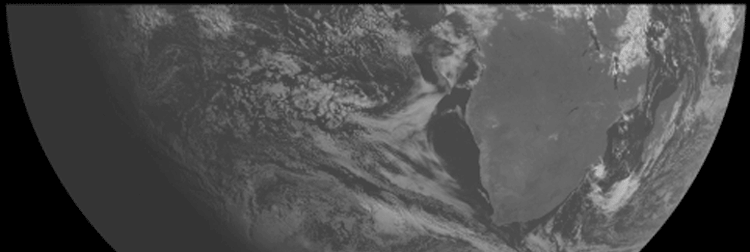
An animation of the movement of the Moon's shadow across the south Atlantic and Africa during the June 2001 total solar eclipse. The darker area is the inner penumbra and umbra, while the lighter area is the outer penumbra. In this particular eclipse the shadow moved across the ground at 1200 miles per hour, so each frame — separated by about 20 minutes — shows the shadow 400 miles further to the east.
(© EUMETSAT, apod021209)

An animation of the movement of the Moon's shadow across China and the South Pacific during the July 22, 2009 total solar eclipse, the longest solar eclipse of the 21st century. The darker area is the inner penumbra and umbra, while the lighter area is the outer penumbra. The animation is apparently no longer available on the NOAA website, but a full-Earth frame from the series (shown below) is still posted at the
National Oceanic and Atmospheric Administration (NOAA) website.

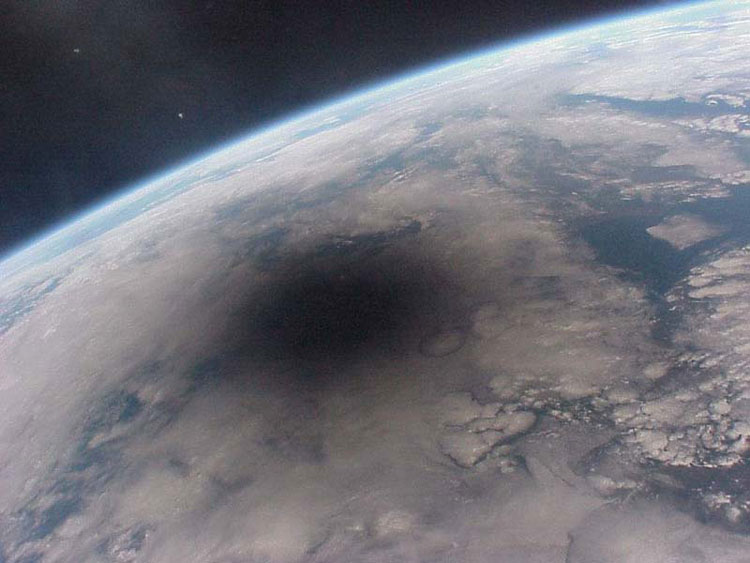
The August 11, 1999 eclipse shadow, from the Mir spacecraft.
(Mir 27 Crew, CNES, apod990830)
The Appearance of the Sun During the Eclipse

Image of total solar eclipse of August 11, 1999
(Michael Kobusch, apod010620)
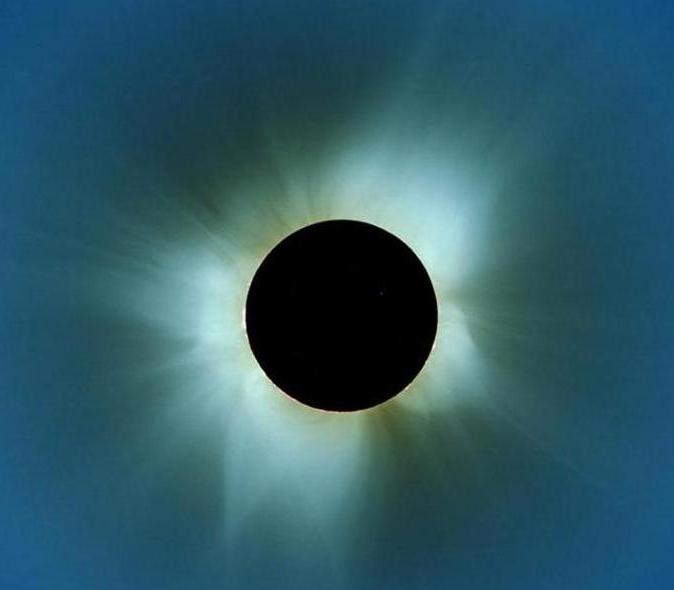
The solar corona, photographed during the eclipse of December 4, 2002.
A specially designed radial density filter shows fainter outer regions as clearly as brighter inner regions. Prior to the space age solar eclipses were the only way to observe the corona, as its fainter regions couldn't be seen amid the scattered sunlight still visible all around the Sun.
(Wendy Carlos & Jonathan Kern, apod021213)
The solar corona photographed during the eclipse of July 22, 2009. Aside from giving an excellent view of the Sun's outer atmosphere, this composite image faintly shows the near side of the moon illuminated by earthlight (the light reflected from a full Earth as seen from the Moon). Note that the features visible on the lunar surface are the same as always, since the Moon always keeps the same face to the Earth.
(Image reproduced by permission of © holder: Miloslav Druckmüller, Peter Aniol, Vojtech Rušin, Lubomir Klocok, Karel Martišek, Martin Dietzel)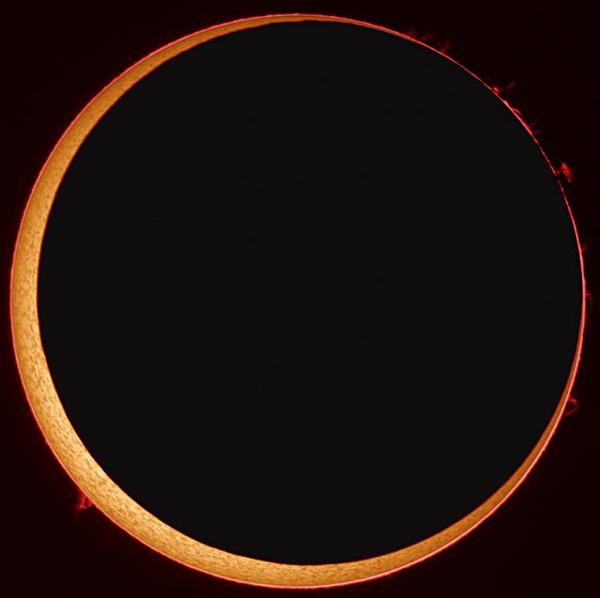
A close-up view of the October 3, 2005 annular eclipse of the Sun. Being further from the Earth than usual, the Moon's angular diameter was smaller than that of the Sun, so a 'ring' or
annulus of sunlight was visible all around the Moon — hence the term, 'annular' eclipse.
(Stefan Seif, apod051005)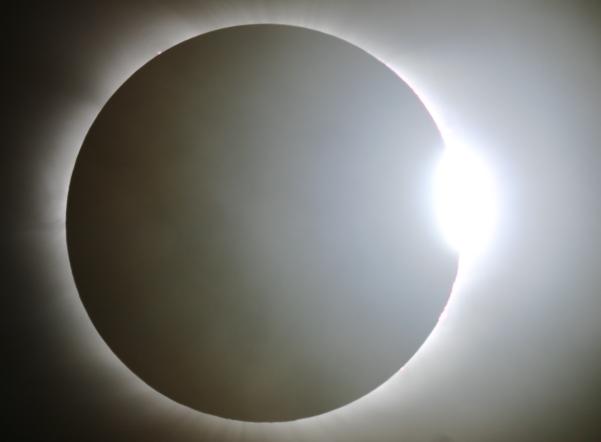
The "diamond ring" effect during the March 29, 2006 solar eclipse. At the start and end of totality, light may shine through valleys on the limb of the Moon, producing brilliant points of light (considerably overexposed here) which dramatically contrast with the black disk of the Moon.
(Anthony Ayiomamitis, apod060330)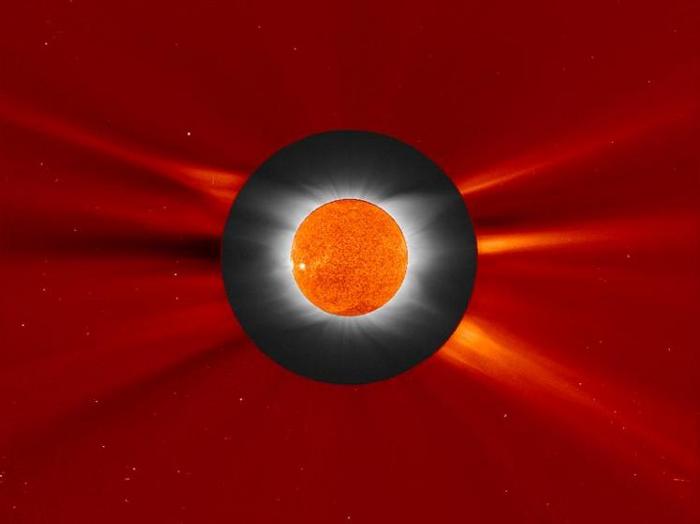
A composite image of the Sun taken during the solar eclipse of March 29, 2006. The central image, in orange, is a view of the Sun taken by the SOHO spacecraft, in a loop orbit a million miles in front of the Earth and Moon (at the
Lagrange point L1). The black and white donut is a view of the inner and middle corona as seen during the eclipse, from the surface of the Earth. And the outer image, in orange, is a view of the outer corona as taken by the SOHO spacecraft. Comparing the images allows the structure of the coronal features to be followed from the surface of the Sun, millions of miles outward into space.
(2006 Team - Williams College Eclipse Expedition, NSF, National Geographic,
SOHO Consortium, ESA, NASA, apod060331)